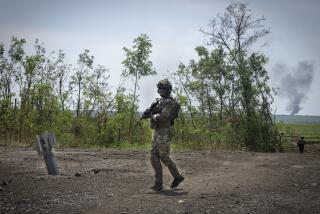Without Air Mastery, Hussein Loses Mobility : Tactics: Republican Guard, mauled by allied raids, will find counterattack impossible.
- Share via
Saddam Hussein thought he had it all figured out. As he had against the Iranian army, he would entrench his army in strong fortified positions, keeping his best and most mobile forces in reserve at the rear.
When the enemy attacked, he would let the assault develop, even let the enemy make initial penetrations of his front lines, until it was clear which were feints and demonstrations, which were secondary attacks--and which was the “real” main attack.
Only then would he commit his reserves in a counterattack to blunt and then destroy the enemy’s main effort and send it reeling back in defeat.
It was not a new tactic. Beginning in the 3rd Century BC, the Chinese used it in defense of the Great Wall. More recently, German Field Marshal Erwin Rommel planned such a defense of the West Wall fortifications on the Normandy coast.
But such tactics depend on one crucial factor. To be successful, the defender must have greater mobility than the attacker. He must be able to get to the point of penetration with superior firepower before the attacker breaks out into open country. But as Rommel found in Normandy, in modern warfare such mobility depends on air superiority over the battlefield.
Without it, you cannot move. Counterattacking Nazi panzer divisions were so harassed and delayed by allied air strikes along their route that they could not reach the front in time to turn back the allied tide.
Saddam Hussein will face the same problem. His elite Republican Guard, already severely mauled by allied air attacks on its reserve positions, will find it impossible to counterattack in its effort to destroy the allied penetration or envelopment of his front-line positions.
The Iraqis face a terrible dilemma. If, in order to survive, Iraqi tanks, armored vehicles and field artillery remain dispersed, covered with sand in their revetments, they are for all intents and purposes neutralized, for they can take no part in the battle. If they emerge from concealment and concentrate in battle formation, however, they invite destruction by A-10 and Apache tank killers and by other allied warplanes.
Thus, it will be Iraqi troops currently dug in along the Saudi-Kuwaiti border, and not Hussein’s more heavily armed reserves, who will provide the major initial opposition to the allied ground attack. Although breaking through these enemy troops will require some hard and bloody fighting, there is little doubt that allied forces will succeed in breaching the Iraqi defensive line. What happens next will be the key to allied victory.
Penetration or envelopment of the enemy fortifications is not an end in itself. It is the prelude to exploitation, “the bold continuation of an attack following initial success,” and pursuit, “the relentless destruction or capture of fleeing enemy forces who have lost the capability to resist.”
As the Army’s war-fighting manual, Field Manual 100-5, explains: “Exploitation is planned as an integral part of the attack. . . . Subordinates watch for indications of enemy withdrawal or reduced resistance. When they occur, commanders issue rapid orders, regroup forces, assign deep objectives and continue the attack.”
Exploitation may be conducted by forces already leading the attack, or fresh forces may be passed into the lead. “Commanders conducting exploitation must be aggressive in reconnaissance, prompt to use firepower and quick to employ uncommitted units,” says FM 100-5. “They clear only enough of their zones to permit their units to advance. Enemy pockets of resistance which are too small to jeopardize the accomplishment of the mission are contained, bypassed or destroyed.”
Behind the exploitation force is the follow and support force. Its job is to widen or secure the shoulders of a penetration, destroy bypassed enemy units, relieve exploitation force units that have halted to contain enemy forces, block the movement of enemy reinforcements and open and secure lines of communication.
Meanwhile, the exploitation force continues to drive deep behind enemy lines in order to seize enemy command posts, sever his escape routes, strike at his reserves, artillery and combat support units and prevent him from reorganizing an effective defense. “As the enemy becomes demoralized and his formations begin to disintegrate,” says FM 100-5, “exploitation may develop into pursuit.”
In the pursuit, the commander attempts to annihilate fleeing enemy forces. Direct pressure “is maintained relentlessly, while an encircling force cuts the enemy line of retreat. . . . It makes maximum use of air assault and air maneuver units (such as the Army’s 82nd Airborne Division and 101st Air Assault Division in Saudi Arabia) in the encircling force.
“An encirclement resulting from a pursuit can completely destroy an enemy force,” the manual states. In April, 1945, for example, massive allied armor and mechanized infantry columns moved out from the Rhine River in pursuit of retreating German forces. Encircling the Ruhr, the U.S. 1st and 9th armies took 325,000 prisoners, totally destroying an entire German army group.
And after Gen. Douglas MacArthur’s successful turning movement at Inchon in the Korean War, the pursuit by X Corps and the 8th U.S. Army effectively destroyed the North Korean army as a fighting force. Only the intervention of Chinese Communist forces saved it from annihilation.
But there is no such force waiting in the wings to save the armies of Saddam Hussein. Their day of reckoning is near at hand.
More to Read
Sign up for Essential California
The most important California stories and recommendations in your inbox every morning.
You may occasionally receive promotional content from the Los Angeles Times.










